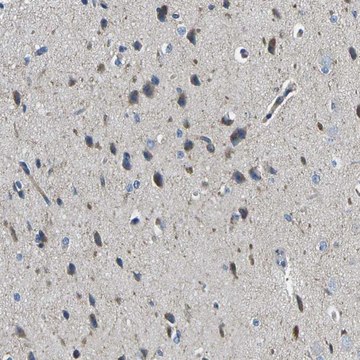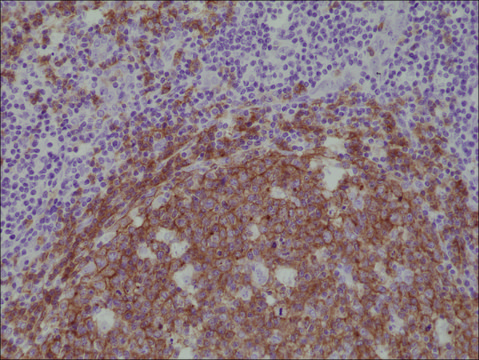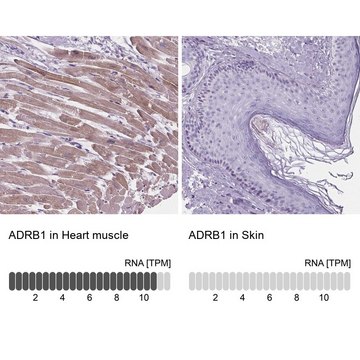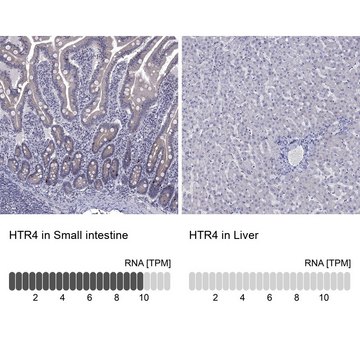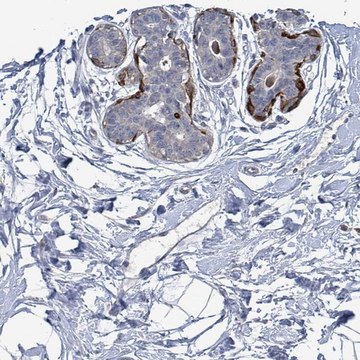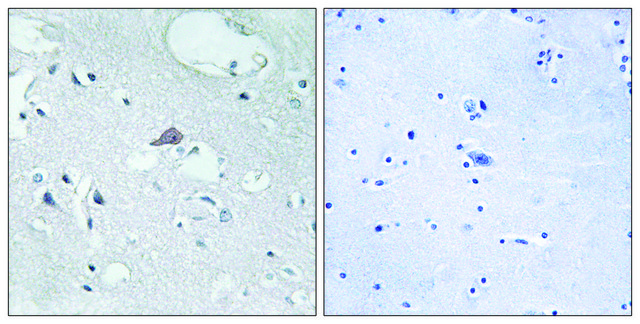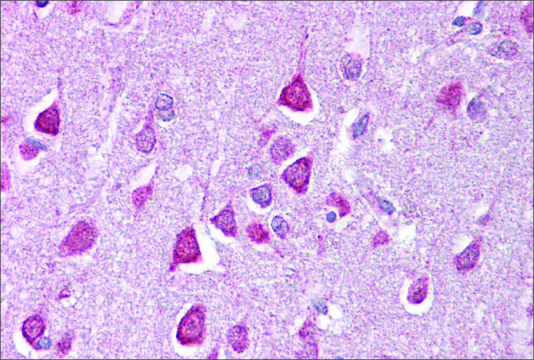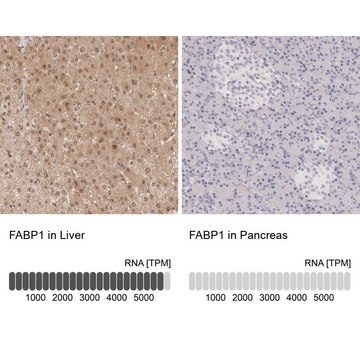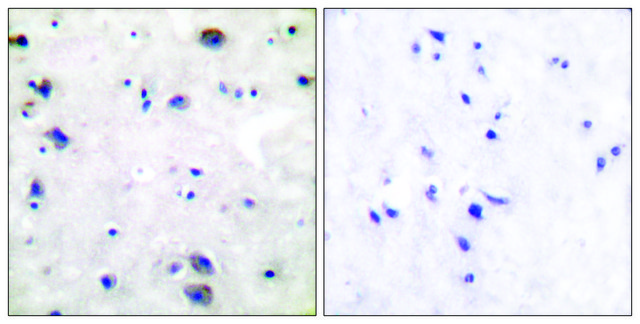推荐产品
生物来源
rabbit
质量水平
偶联物
unconjugated
抗体形式
affinity isolated antibody
抗体产品类型
primary antibodies
克隆
polyclonal
产品线
Prestige Antibodies® Powered by Atlas Antibodies
表单
buffered aqueous glycerol solution
种属反应性
human
技术
immunohistochemistry: 1:20- 1:50
免疫原序列
LTLLSVSARTGFCKKQQELWQRRKEAAEALGTRKVSVLLATSHSGARPAVSTMDSSAAPTNASNCTDALAYSSCSPAPSPGSWVNLSHLDGNLSDPCGPNRTDLGGRDSLCPPTGSP
UniProt登记号
运输
wet ice
储存温度
−20°C
靶向翻译后修饰
unmodified
基因信息
human ... OPRM1(4988)
一般描述
The gene OPRM1 (opioid receptor μ 1) is mapped to human chromosome 6q24-q25. The gene spanning a length of 200kb contains 11 exons that yield 17 splice variants.
免疫原
Mu-type opioid receptor recombinant protein epitope signature tag (PrEST)
应用
All Prestige Antibodies Powered by Atlas Antibodies are developed and validated by the Human Protein Atlas (HPA) project and as a result, are supported by the most extensive characterization in the industry.
The Human Protein Atlas project can be subdivided into three efforts: Human Tissue Atlas, Cancer Atlas, and Human Cell Atlas. The antibodies that have been generated in support of the Tissue and Cancer Atlas projects have been tested by immunohistochemistry against hundreds of normal and disease tissues and through the recent efforts of the Human Cell Atlas project, many have been characterized by immunofluorescence to map the human proteome not only at the tissue level but now at the subcellular level. These images and the collection of this vast data set can be viewed on the Human Protein Atlas (HPA) site by clicking on the Image Gallery link. We also provide Prestige Antibodies® protocols and other useful information.
The Human Protein Atlas project can be subdivided into three efforts: Human Tissue Atlas, Cancer Atlas, and Human Cell Atlas. The antibodies that have been generated in support of the Tissue and Cancer Atlas projects have been tested by immunohistochemistry against hundreds of normal and disease tissues and through the recent efforts of the Human Cell Atlas project, many have been characterized by immunofluorescence to map the human proteome not only at the tissue level but now at the subcellular level. These images and the collection of this vast data set can be viewed on the Human Protein Atlas (HPA) site by clicking on the Image Gallery link. We also provide Prestige Antibodies® protocols and other useful information.
生化/生理作用
The gene OPRM1 (opioid receptor μ 1) encodes a μ opioid receptor that functions in pain perception and addiction to drugs of abuse, such as cocaine, nicotine, and alcohol. It serves as a target for opioid drugs, such as morphine, methadone and heroin, and opioid peptides, such as β-endorphin and endomorphins, and mediates their effects. Single nucleotide polymorphism A118G in this gene is associated with an inclination to drug addiction and lesser response to painful stimuli.
特点和优势
Prestige Antibodies® are highly characterized and extensively validated antibodies with the added benefit of all available characterization data for each target being accessible via the Human Protein Atlas portal linked just below the product name at the top of this page. The uniqueness and low cross-reactivity of the Prestige Antibodies® to other proteins are due to a thorough selection of antigen regions, affinity purification, and stringent selection. Prestige antigen controls are available for every corresponding Prestige Antibody and can be found in the linkage section.
Every Prestige Antibody is tested in the following ways:
Every Prestige Antibody is tested in the following ways:
- IHC tissue array of 44 normal human tissues and 20 of the most common cancer type tissues.
- Protein array of 364 human recombinant protein fragments.
联系
Corresponding Antigen APREST72740
外形
Solution in phosphate-buffered saline, pH 7.2, containing 40% glycerol and 0.02% sodium azide
法律信息
Prestige Antibodies is a registered trademark of Merck KGaA, Darmstadt, Germany
免责声明
Unless otherwise stated in our catalog or other company documentation accompanying the product(s), our products are intended for research use only and are not to be used for any other purpose, which includes but is not limited to, unauthorized commercial uses, in vitro diagnostic uses, ex vivo or in vivo therapeutic uses or any type of consumption or application to humans or animals.
未找到合适的产品?
试试我们的产品选型工具.
储存分类代码
10 - Combustible liquids
WGK
WGK 1
闪点(°F)
Not applicable
闪点(°C)
Not applicable
个人防护装备
Eyeshields, Gloves, multi-purpose combination respirator cartridge (US)
法规信息
新产品
Heidelinde Fiegl et al.
Gynecologic oncology, 165(1), 129-136 (2022-01-17)
The opioid agonist D,L-methadone exerts analgesic effects via the mu opioid receptor, encoded by OPRM1 and therefore plays a role in chronic pain management. In preclinical tumor-models D,L-methadone shows apoptotic and chemo-sensitizing effects and was therefore hyped as an off-label
Ying Zhang et al.
The Journal of biological chemistry, 280(38), 32618-32624 (2005-07-28)
As a primary target for opioid drugs and peptides, the mu opioid receptor (OPRM1) plays a key role in pain perception and addiction. Genetic variants of OPRM1 have been implicated in predisposition to drug addiction, in particular the single nucleotide
Jörn Lötsch et al.
Anesthesiology, 97(4), 814-819 (2002-10-03)
Some, but not all, patients with renal dysfunction suffer from side effects after morphine administration because of accumulation of the active metabolite morphine-6-glucuronide (M6G). The current study aims to identify genetic causes that put patients at risk for, or protect
Shinya Kasai et al.
Pharmacogenomics, 12(9), 1305-1320 (2011-09-17)
The µ-opioid receptor is a primary target for clinically important opioid analgesics, including morphine, fentanyl and methadone. Many genetic variations have been identified in the human µ-opioid receptor MOP gene (OPRM1), and their implications have been reported in the effects
Raymond F Anton et al.
Archives of general psychiatry, 65(2), 135-144 (2008-02-06)
Naltrexone hydrochloride treatment for alcohol dependence works for some individuals but not for everyone. Asn40Asp, a functional polymorphism of the mu-opioid receptor gene (OPRM1), might predict naltrexone response. To evaluate whether individuals with alcoholism who are heterozygous (Asp40/Asn40) or homozygous
我们的科学家团队拥有各种研究领域经验,包括生命科学、材料科学、化学合成、色谱、分析及许多其他领域.
联系技术服务部门